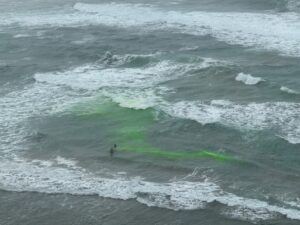COMBATING THE DANGERS OF RIP CURRENTS IN THE GARDEN ROUTE AREA

Media Release issued on behalf of NSRI

COMBATING THE DANGERS OF RIP CURRENTS IN THE GARDEN ROUTE AREA
NSRI Releases Fluoresceine Dye to highlight the danger of rip currents
15 December 2022: In the heart of South Africa’s Garden Route in the Southern Cape area you will find Herolds Bay. This is a peaceful place blessed with the songs of the wind and the ocean. However, there are dangerous RIP currents in this area.
This is according to the National Sea Rescue Institute (NSRI) who recently used a harmless green dye to highlight rip currents at Herolds Bay and Wilderness beach. We believe that Rip currents are the greatest danger that holidaymakers will face when they flock to the beaches during this holiday season and want to draw this danger to the attention of people holidaying at the coast.
“Many people find rip currents hard to see and so we have used Fluoresceine dye in a once-off deployment to highlight a couple of them so that we could photograph and film the dye being pulled out in the rips. We will use these photos and video as educational tools to teach beach safety,” said NSRI’s Wilderness Station Commander Mike Vonk.
“Many beaches around South Africa have powerful rip currents which can pull a swimmer away from the beach to behind where the waves form in a couple of minutes,” he continued.
“A rip current will not pull you under the water, but will pull a swimmer away from the beach,” said Mike. “If caught in a rip the most important thing is not to panic. Swim out of the current at 90 degrees to the direction in which you are being pulled and use the waves to swim back to shore. Or flip on your back and float until the current runs out of strength and you can swim back to the beach,” he added.
NSRI Drowning Prevention manager Andrew Ingram has some important advice on how to assist a person caught in a rip current. “Call NSRI for help by dialing 112 from your cell phone, save the NSRI’s National Emergency Operations Centre in your phone (087 094 9774) or Google ‘Sea Rescue emergency’ for the closest NSRI stations’ number. And never go into the water to attempt a rescue without taking something that floats with you,” adds Andrew. Our Pink Rescue Buoys are available on many beaches as well as some rivers and dams to be used as emergency flotation for anyone to use to protect themselves while they attempt to help a swimmer in distress. Surfboards or body boards are also good choices to protect yourself and help the person in difficulty if you decide to go into the water to help.”
“Out of 131 rescues that we know of, where a Pink Buoy has been used to help someone in difficulty, 96 of these people needed help because they were swimming in a rip current,” said Andrew.
“Pink Buoys save lives, and we appeal to everyone to take note of where they are placed on beaches. They are there for use in an emergency and should be put back after use,” he said. “If you see that a Pink Buoy is missing, please call the cell number on the sign and let us know.”
“We encourage people to swim at a beach that is lifeguarded and to swim between the lifeguard’s flags,” said Mike Vonk. “If lifeguards are not on duty, it is safer not to swim,” he added.
“Parents please watch your children when they are in or near water and remember that drowning is silent. Please save the emergency numbers in your cellphone before you need it and have a safe holiday,” concludes Mike.
Note to editors:
1. Fluoresceine Dye is harmless. It is used by doctors to see issues in patients’ eyes, by plumbers to detect leaking pipes and by fishermen to attract fish. The NSRI has a permit issued by DFFE to release the dye in the educational and research work that the organization is doing regarding rip currents.
2. Please see the NSRI Rip current video on our YouTube channel which explains how rip currents work – https://youtu.be/9GBUBDMENfw .
3. If anybody would like to help us with our Pink Rescue Buoy program as a Pink Buoy custodian or Pink Buoy volunteer please contact us on our social media channels or email us: pinkrescuebuoys@searescue.org.za .
Kindest Regards,
KUHLE MKIZE
COMMUNICATIONS & PR MANAGER
